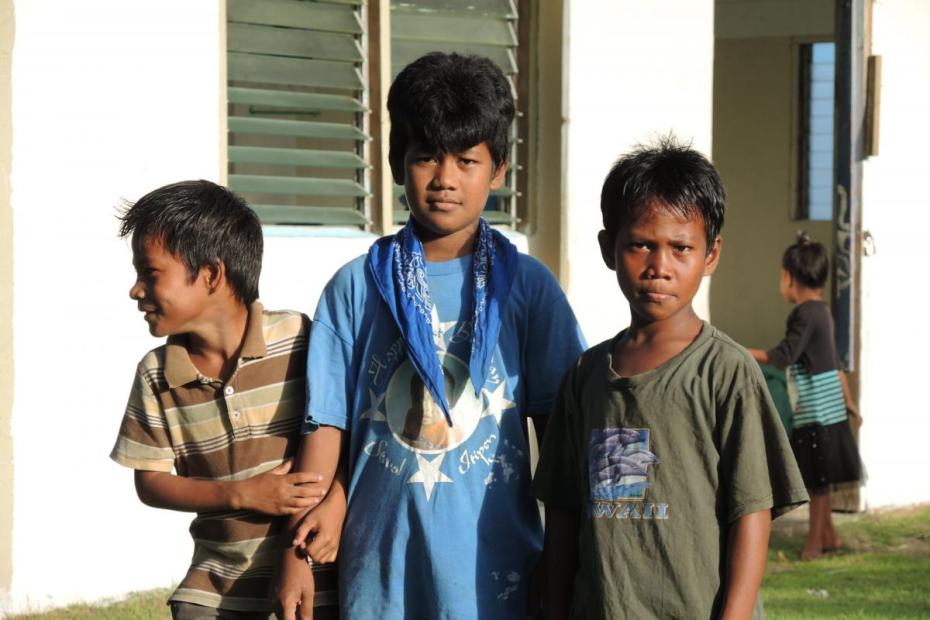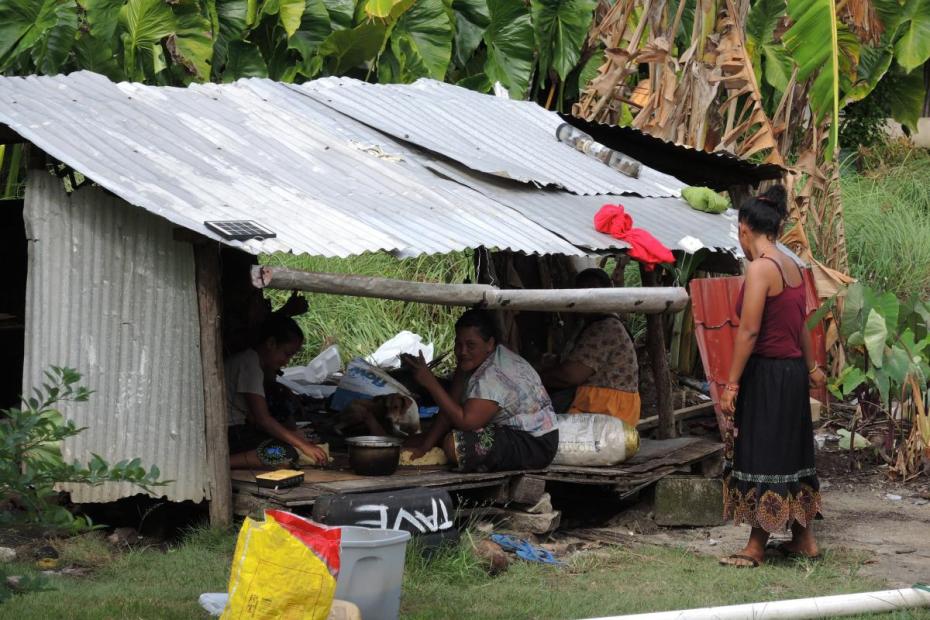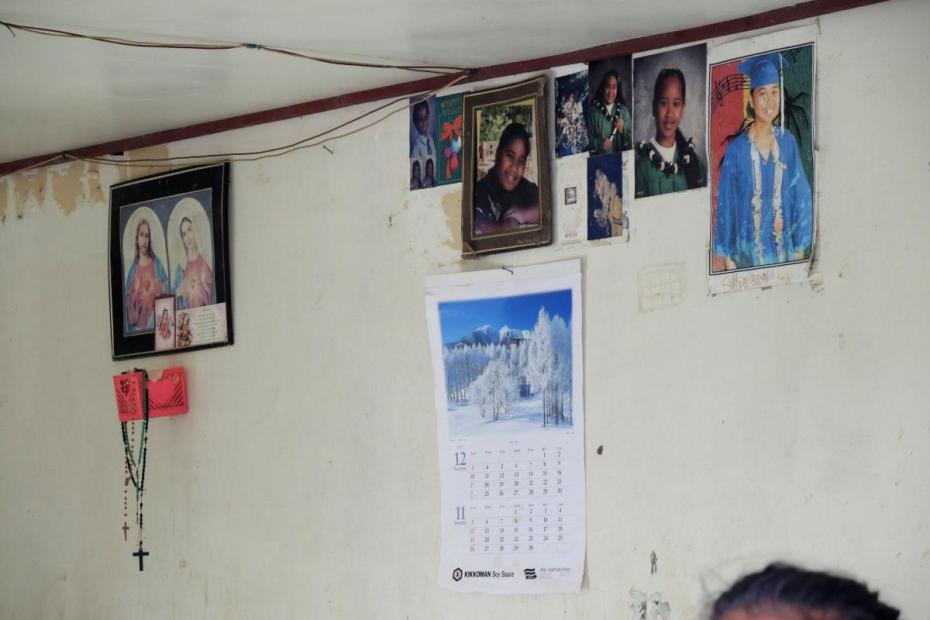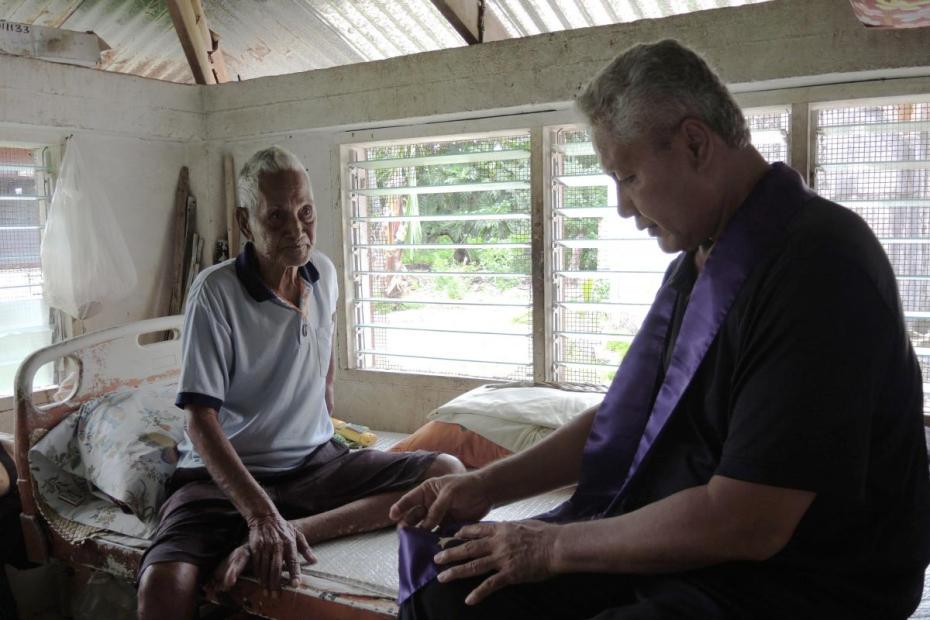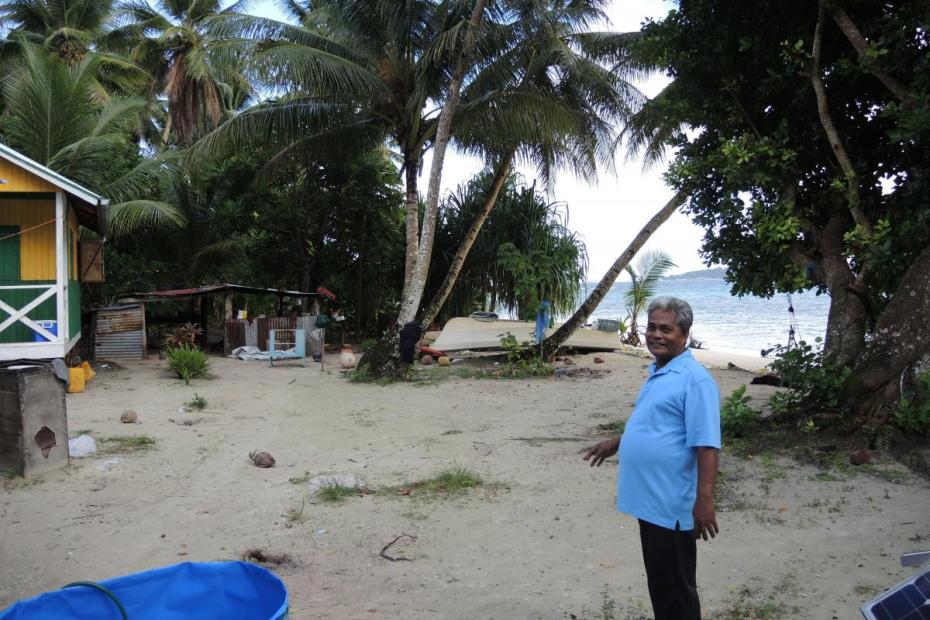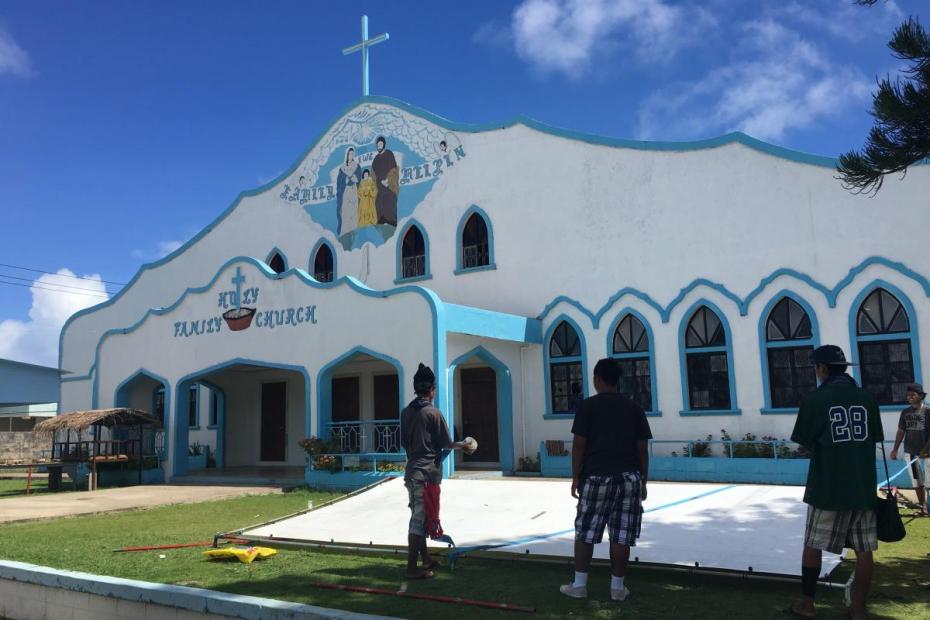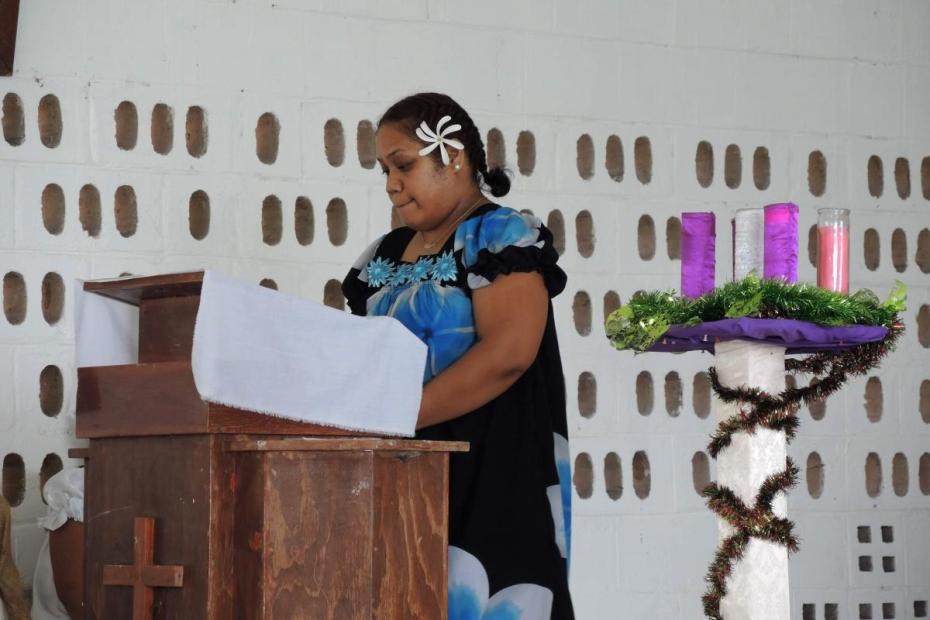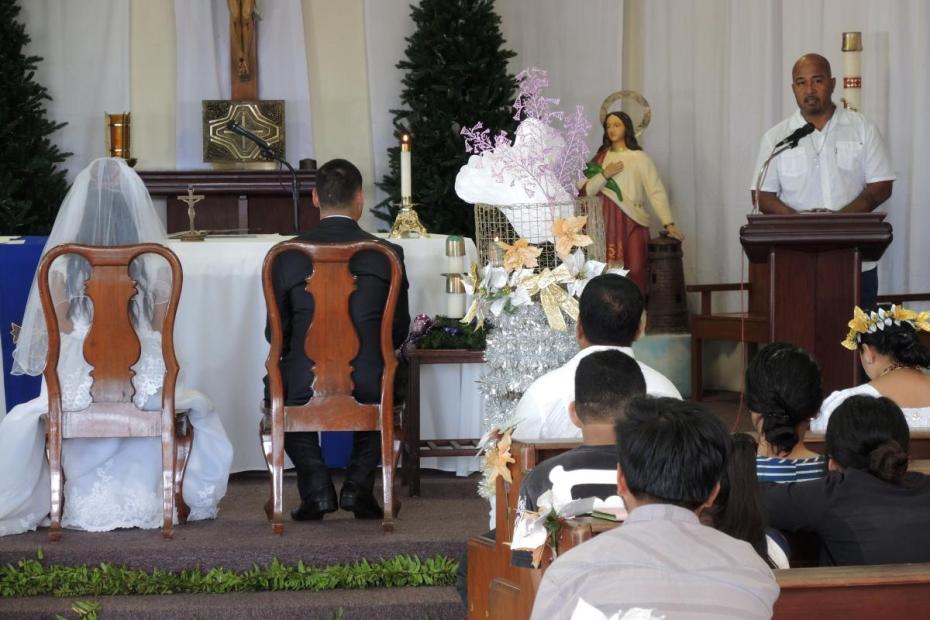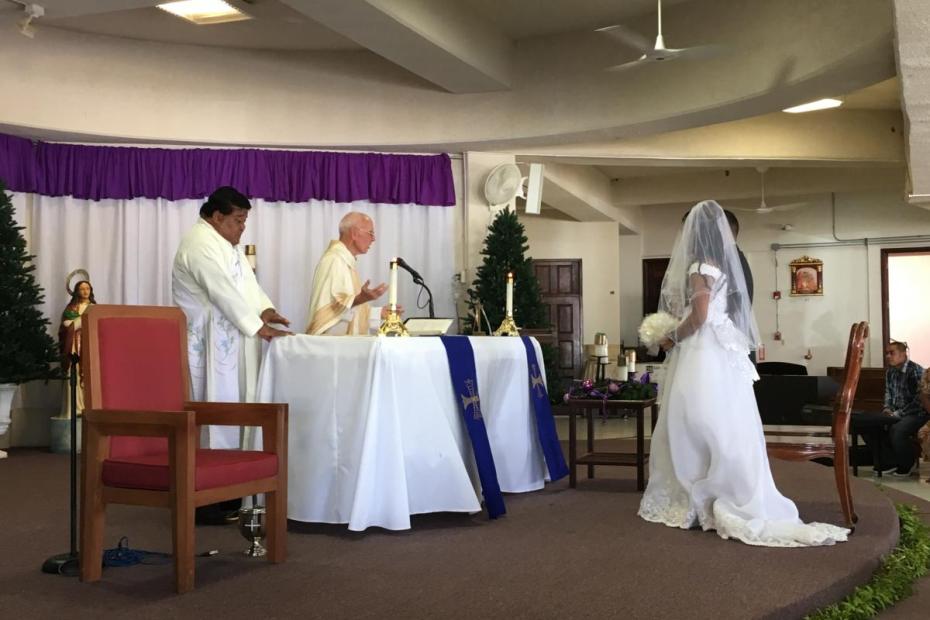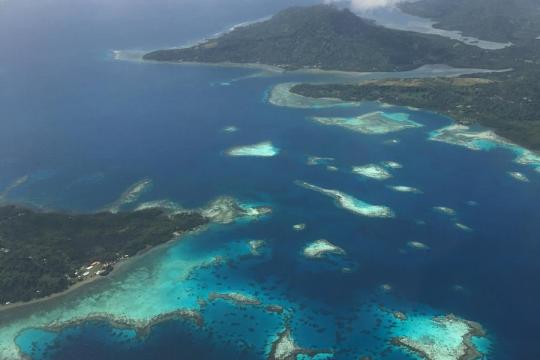It is hard to overstate the power that a family has to shape the lives and interactions of Chuukese people. How that works—who in the family is due particular respect, how it must be demonstrated, and even what “family” means—is remarkably different from expectations in most of the rest of the world. Several interviewees for this research expressed real anxiety about the decline of the family, but paradoxically, what they worried about was the rising prevalence, in a few contexts in the capital, Weno, and in the migrant community on Guam, of some of the norms and values of the Western nuclear family. To them, the advent of a number of contemporary social problems is in large part a result of the decline of local traditional norms for family life. The Western nuclear family structure (father, mother and children living in their own distinct household), they said, makes it hard to enforce the web of mutual obligation, respect and sharing that are embedded in the Chuukese traditional family structure.1
The idea that family determines the lives of Chuukese people does not simply refer to some formative legacy from childhood and adolescence that reverberates throughout one’s life. Interactions even among adults are structured according to powerful deference codes that establish hierarchies of relationship based on even minor differences in age among kin in one’s own and one’s parents’ generation in the lineage.2
Lineage groups, not the Western nuclear family, have long been the most determinative family structure in Chuuk. “Micronesian societies are organized around interlocking lineages and clans. Lineages are relatively small groups, for the most part located within single communities… The lineages possess land and control political titles, regulate marriages, provide the matrix within which child rearing takes place, and in general endow individual Micronesians with a sense of personal identity. Micronesians draw upon their families’ lands and the landscapes and seascapes of their home islands for some part of their sense of self, and they draw as well upon their communities. But their personas as members of these communities are formed in the lineages in which they are raised, and as actors in the social dramas of everyday life they are always rooted in their lineages.”3
Hezel observes, “In Chuuk during the years following World War II, a ‘family’ was usually composed of the core of a lineage—the women and their children, along with all in-marrying men, numbering perhaps two or three dozen people in all.” Compounds had small huts for couples and their children to sleep and common cooking and meeting areas.4
It is the mother’s lineage, far more than the father’s, that shapes day-to-day life. Property traditionally, and in most instances today, belongs collectively to the maternal lineage, and is allocated within that lineage. By tradition, a new husband moves onto property belonging to his wife’s lineage, and lives there all his life.5 Furthermore, “the senior women in the lineage decided who was to have the use of what piece of lineage land.”6 There are cases where land could have to be given away, but even there, “the women of the lineage held veto rights over the chief’s power to dispose of family land.”7 In cases where the husband fails too seriously at his role, he is sent away from the wife’s lineage’s property, and needs to ask to be taken back onto land belonging to his own maternal lineage. Though there are exceptions, as discussed below, and the matrilineal system is more frequently contested today, this system is still the default one, especially in villages.
American culture often idealizes the person who moves away from the bonds of family to “find” or “make” himself in some new way. Francis Hezel, S.J., longtime Chuuk resident and author of many books about Micronesia, describes such aspirations as fundamentally antithetical to Chuukese thinking. Exclusion from the family is a frightening thought, even though membership in the family poses many demands. One “finds” oneself only within the family and community structure one comes from, not by leaving it.8
Respect, deference and modesty are core cultural values. These values play out within the family in particular. Respect is demonstrated through distance, deference, and silence, and often through physically lowering oneself in the presence of a superior, which makes for particular family dynamics. In family and elsewhere, “respect is shown today, as it always has been, by acknowledging the social distance separating the authority figure and the subject. This is often done by avoiding familiarity with the person in authority.”9 This defines relationships between father and son, and between siblings. Brothers owe great deference to each other, which puts them in relationships that can never be casual and informal.10 Husbands and wives do not show affection in public.11 Parents don’t show emotional affection to their children after infancy. Children thereafter are raised to know their role, to be deferential to others, and not to regard themselves as special or deserving. Generous praise and positive reinforcement are not part of childhood: “Self-deprecation is a large part of island style, and nowhere does it come into play more than when a parent refers to his or her own children.”12 Love is shown instead through sharing food and resources. Hezel writes, “it was the shared food itself, not the act of eating together” even in families, that signals love and care. Food gifts are how you show love, solidarity and support, but the meals themselves are not occasions to prompt emotional conversation and discussions.13
The emphasis here on family obligation, social distance, and the style of child rearing could sound bleak to outsiders, but it is fair to say that in every encounter for this research, people were kind and generous. Social norms strongly discourage expression of anger, and in general Chuukese are remarkably calm people, and generous, especially with food.
The article on worship in Chuuk identifies a number of ways that familial relations of deference impact Catholic worship. The article on the importance of reconciliation as a cultural value explains how, in cases of major crimes committed by an individual, the resolution involves whole families, not simply the individual involved.
Another manifestation of the respect culture in the family is that there is absolutely “no talk of sex within the family.”14
Marriage
The traditional form of marriage in Chuuk, as interviewees described it, entailed a couple choosing one another, often sleeping together discreetly beforehand. That process was always discreet. There was no system of dating or public courtship. When a couple wanted to make their relationship “official,” i.e. public, representatives of the man’s family would approach the woman’s family to ask their permission. Even if the young people chose each other, marriage was fundamentally an agreement between families. The meeting of families was arranged ahead of time, to gather all the appropriate lineage members. Parents, uncles and aunts presented a case in favor of the union. The prospective husband spoke at the end, after which the bride might or might not speak. Either family could veto the arrangement, and their decision carried absolute weight. Every interviewee could think of many occasions when the families said no, but were not specific why. Families in Chuuk today more readily cede the decision about marriage to the couple’s own desire, but the right of the parents to intervene is only mitigated, not eliminated.15
There are more options for dating today, but marriage, as it is understood there, still tends to take place first in the traditional cultural form: once the families give permission, and the couple sleeps together, the couple is considered married. Some Catholics challenged the norm, arguing that church marriage from the start is proper, but the cultural norm is still powerful, and the Church has had limited impact on it. A civil marriage might come years later, and a church marriage long after that. One woman interviewee noted that the government bureaucratization was accomplishing what the churches long had a harder time doing. Couples who want to migrate, or receive some kinds of family-based benefits, or ensure inheritances, need to present paperwork that a civil or church officiant had witnessed the marriage. One priest reported that too many of his parishioners wanted to be married as late as on their deathbeds, to secure inheritances for their spouse and children.
People cannot marry within their own clan (a much larger group than the matrilineal-based family lineage group) or lineage. Therefore, information about who belongs to what clan is important. Clans are so big and so diffuse, spread to several islands, that people will never know all the people who belong to a clan. But when it comes to marriage, they need to know what clan an individual belongs to.
Childhood and adolescence
Children are raised to know their place in the hierarchy and the family, and to not evade their responsibilities to it. Education at school is seen as important, not simply for the well-being of the individual, but of the family.
In a culture where infant mortality was once very high, the celebration of a baby’s first birthday—much more than the celebration of the birth itself—is an occasion for a major feast.
Gendered roles
Traditional roles were and are firmly defined by gender, though there are variations from island to island. Broadly speaking, women were associated with the land, while men’s roles took them to sea. Typically, women wove fabrics, made mats, fished with nets near the shore, and were responsible for serving the main meal and cooking fish; men wove rope, made nets and tools, did woodworking, tended trees, planted taro, and did the fishing further out in boats, and were responsible for some food preparation.16 On Pulap, one of Chuuk’s Outer Islands, women control the land, tend Taro gardens, and do some close-in fishing, while men fish. Interestingly, women there identified “being strong in religion” as one of the key roles expected of women, along with settling disputes/making peace, instructing/admonishing/telling people how to behave, caring for children and the elderly, and taro gardening.17 Juliana Flinn identifies a number of ways that Mary serves as a model of womanhood for Pollapese women, in ways that might be striking to readers from other cultures.
Chuukese consider it quite indecent for women to show thighs. Women at church, and on other important occasions, favor distinctive, flowered muumuu dresses that reveal very little and that cover their legs. Men dress modestly too. If they wear shorts, these at least extend to their knees. Young children have some leeway in terms of clothing norms.
Without doubt the most distinctive gendered element of Chuukese culture is the form of deference that sisters must show to brothers and uncles. Video from a reconciliation service on the island of Fono shows the traditional system expects that women show deference toward “brothers”—a category that includes their own brothers and maternal uncles, but not their fathers or husbands—by not standing higher than them in their vicinity. This could entail just bending low when walking near them, or even crawling from place to place on the floor when the men are sitting in the room. Similarly, they should never touch these brothers, or feed them directly.
This form of gendered deference is particularly striking to outsiders, but Flinn asserts that the collective reality is more complicated: “Even the public deference shown to brothers, an explicit component of tradition that appears to support the subordination of women, is nonetheless quite complex and provides women with room for maneuvering. Furthermore, this deference is a part of a larger system of respect and ranking such that everyone—male and female—defers to someone else… and the more senior a woman is, the more she is respected, attended to, and even expected to offer advice and have influence in the community.”18
Among a group of a dozen male and female students interviewed at Chuuk’s Xavier High School, all were certain, and hopeful, that these rules for respect and deference in the family wouldn’t change, since these were regarded by them as integral to their culture. They saw the values as firmly implanted on their generation, even as they thought other values in their communities—notably religiosity—were in decline, among their peers.
Catholicism has not diminished this practice of deference to brothers, but it has added an overlay of expectations for deference: obedience to husbands.19 This has been successful only to a limited degree. The Church teaches that a married couple becomes one flesh, but local tradition teaches that only lineage relationships are truly permanent and unchanging.20 A highly problematic husband can be dispensed with. A Catholic marriage just makes that harder.
Catholic norms around abortion are consonant with mainstream beliefs around abortion, but in tension over contraception. Flinn reports, “Pollapese have heard of abortion but have no conception of why it is necessary: they take it for granted that a child in their society will inevitably have someone to care for it.” Still, she says, “a number of Pollapese women nevertheless want some control over their childbearing but find it difficult if not impossible because of the Catholic church’s ban on birth control.”21
The problem behind the transition to the nuclear family
The peoples of Chuuk have slowly moved towards adapting to nuclear family norms since World War II, with encouragement from missionaries, but also because of changes brought about by migration out of villages to town for government and business jobs.22 One of the two big Catholic churches in Weno is even named Ewe Family Mei Pin—Holy Family Church—though it is telling that the word for family has to be copied from English, to distinguish it from native Chuukese concepts of lineage.
The transition to nuclear families is far from total. Hezel has traced some of the transformation and its effects, and ordinary Micronesians interviewed for this project feel its impact as well.23 The role of the lineage heads is diminished. On islands and in villages where there is still a subsistence economy, people remain most dependent on the land and the lineage that controls it. But where there has been a shift to a cash economy, the role of the heads is diminished.24 So too has child rearing retreated from being an almost wholly lineage-based responsibility to being the responsibility of the nuclear family, especially the mother. In instances where land has come to belong to a household with a male head, rather than to a female lineage, women are more vulnerable too.25
As Hezel points out, the broader safety net of lineage and clan that once protected women and children, whatever its flaws, is much diminished. Maternal uncles, whose responsibility it would once have been to intervene in case of problems caused by a husband, or in light of any family problem, now lack such power. Whereas elder lineage members were often also called “mother” or “father” by children, new terms, “aunt” and “uncle” are adopted, with the diminished authority they imply in the Western nuclear family.26
Whereas large lineage-based households once gathered and shared resources collectively, heads of individual households are more responsible for their own family’s needs, particularly in the wage economy households. By most other cultures’ standards, families and individuals are exceptionally generous with food and resources. But today, in town at least, each house has its own food storage and kitchen, not the common stores that are allocated by chiefs in the more traditional island communities. “Eleanor,” a Chuukese who has lived in Guam for decades, spoke of her real loss of bearing when she returns home. When last visiting Chuuk, she reported, “I tell my nieces and nephews, ‘Go next door and ask for breadfruit from auntie’ so-and-so. And then my other auntie stops me and says, ‘Oh no. Don’t do that. We don’t do that.’ And I say, ‘Why? But we used to do that.’ ‘No, not now,’ they respond.” Eleanor sees a lot more violence than she saw in the past, and links this to the decline of the old family ways of life. “The fabric of the family now is a little loose, is not like it was before. Even though the closeness is still there... it's not like before.”
Not all shifts in family life and responsibilities derive from the shift to the nuclear family. Hezel points that burdens in family life are shifting away from men but are unmitigated for women. Some of the most time-consuming aspects of men’s work, like rope making and boat building, have disappeared in the era of fiberglass boats and store-bought rope and nets. Though men and women once had exacting, complementary responsibilities over the preparation of breadfruit, which is intensive work, many families’ shift to eating rice puts all that work on women, and almost none on men.27
- 1The entries here are based on 12 interviews and many more informal conversations at sites in Chuuk and Guam, and the written sources cited. Particular thanks is due to Francis X. Hezel, S.J., author and long-time steward of the Micronesia Seminar, whose writing is also a foundation for the entries that appear for Micronesia on this site. He also facilitated many of the contacts that led to interviews and site visits. As noted below, he has made extended observations about contemporary challenges posed by modernization in Micronesia.
- 2For a broad overview of the implications of kinship and identity, see Francis X. Hezel, S.J., Making Sense of Micronesia: the Logic of Pacific Island Culture (Honolulu: University of Hawai’i, 2013), 11-36.
- 3Glenn Petersen, Traditional Micronesian Societies: Adaptation, Integration, and Political Organization in the Central Pacific (Honolulu: University of Hawai’i, 2009), 2. Clans, which the quoted passage alludes to, are another complex layer of “familial” relationship, but are largely outside the scope of this discussion, since they seem to lack the same impact on family life, except as noted below. For an extended explanation of clan and lineage in Micronesian societies generally, see Peterson, chapter four, “Descent and Descent Groups” in Traditional Micronesian Societies, 66-84.
- 4Francis X. Hezel, S.J., The New Shape of Old Island Cultures: A Half century of Social Change in Micronesia (Honolulu: University of Hawai'i Press, 2001), 8-9.
- 5On the complexities of these property relationships in pre-colonial times, see Ward Goodenough, Under Heaven's Brow: Pre-Christian Religious Tradition in Chuuk (Philadelphia: American Philosophical Society, 2002), 30-45.
- 6See Hezel, The New Shape of Old Island Cultures, 58.
- 7Hezel, The New Shape of Old Island Cultures, 58.
- 8Hezel, Making Sense of Micronesia, 24-48.
- 9Hezel, The New Shape of Old Island Cultures, 16.
- 10Hezel, Making Sense of Micronesia, 89.
- 11Hezel, Making Sense of Micronesia, 135-139.
- 12Hezel, Making Sense of Micronesia, 128-130.
- 13Hezel, Making Sense of Micronesia, 50.
- 14Hezel, Making Sense of Micronesia, 114.
- 15Hezel, Making Sense of Micronesia, 79-90, 108-113.
- 16Ward Goodenough, Under Heaven's Brow: Pre-Christian Religious Tradition in Chuuk (Philadelphia: American Philosophical Society, 2002), 25-26; Hezel, Making Sense of Micronesia, 8. On the exceptions, see Petersen, Traditional Micronesian Societies, 93-94.
- 17Juliana Flinn, Mary, the Devil, and Taro: Catholicism and Women's Work in a Micronesian Society (Honolulu: University of Hawai'i Press, 2010), 37-65. The multiple words between slash marks refer to multiple senses of the same word in English translation.
- 18Flinn, Mary, the Devil, and Taro, 95.
- 19Flinn heard language about deference to husbands only in the context of discussion about Catholicism on Pulap, not in traditional contexts. Flinn, Mary, the Devil, and Taro, 128.
- 20Hezel, The New Shape of Old Island Cultures, 14.
- 21Flinn, Mary, the Devil, and Taro, 129.
- 22On the missionary role, see Flinn, Mary, the Devil, and Taro, 4.
- 23This is a primary subject of Hezel’s The New Shape of Old Island Cultures, which traces changes since Hezel arrived in Chuuk in 1963.
- 24Hezel, The New Shape of Old Island Cultures, 12-13.
- 25Hezel, The New Shape of Old Island Cultures, 33-45.
- 26Hezel, The New Shape of Old Island Cultures,15-28.
- 27Hezel, The New Shape of Old Island Cultures, 46-56.
